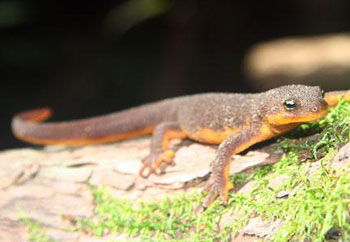Salamanders dying due to common pesticide
Salamanders dying due to common pesticide
mongabay.com
March 25, 2007
Atrazine, one of the most widely used pesticides in the United States, may be killing salamanders, according to American biologists writing in the journal Environmental Health Perspectives.
The researchers say that while the impacts of atrazine may not show up in short-term studies, there should be concerns about its long-term effects.
“We are concerned that most studies used to make pesticide registration decisions and to derive safe concentrations last for about four days,” said Jason R. Rohr, a research associate at the Penn State University Institutes of Energy and the Environment. “They often do not consider recovery processes, persistent effects of chemical exposure, or interactions among individuals within and between species that can affect our estimates of safe chemical concentrations.”
Analyzing the effects of various concentrations of atrazine on salamanders, the researchers found that even low levels of atrazine exposure significantly increased salamander mortality.
 Rough-skinned newt (Taricha granulosa) in California. Photo by Rhett A. Butler |
“The biggest surprise was that it took nearly a year to detect the effects of atrazine at 4 parts per billion, which is just 1 part per billion above the maximum allowable level in drinking water set by the U.S Environmental Protection Agency,” said Rohr. “What this tells me is that we need to consider the long-term effects of chemicals, and that exposure to atrazine during formative stages might have permanent effects on these salamanders that increases their risk of mortality.”
Rohr and his colleagues Timothy M. Sesterhenn, Brent D. Palmer, and Tyler Sager of the University of Kentucky, Lexington, say it is unclear how atrazine kills salamanders, but that other research has suggested the herbicide is an endocrine disruptor that can affect production of sex hormones.
The authors say their research have broader implications for the worldwide decline in amphibians.
“Salamanders, and amphibians in general, are crucial to ecosystems, as both predators and prey. They can be seen as bioindicators of environmental stress and harbingers of risk to other animals as well as humans,” concluded Rohr.
Scientists say amphibians — cold-blooded animals that include frogs, toads, salamanders, newts and caecilians — are under grave threat due to climate change, pollution, and the emergence of a deadly and infectious fungal disease, which has been linked to global warming. According to the Global Amphibian Assessment, a comprehensive status assessment of the world’s amphibian species, one-third of the world’s 5,918 known amphibian species are classified as threatened with extinction. Further, at least 9, and perhaps 122, have gone extinct since 1980.
Related article
Pesticides threaten cloud forests in Costa Rica – new study.
Pesticides from coffee and banana cultivation are accumulating in Costa Rica’s biodiverse cloud forests according to research published earlier this month in Environmental Science & Technology (ES&T). The findings have implications for conservation efforts in both the Central American country and in other parts of the world.
This article uses quotes and information from a Penn State news release and previous mongabay.com articles